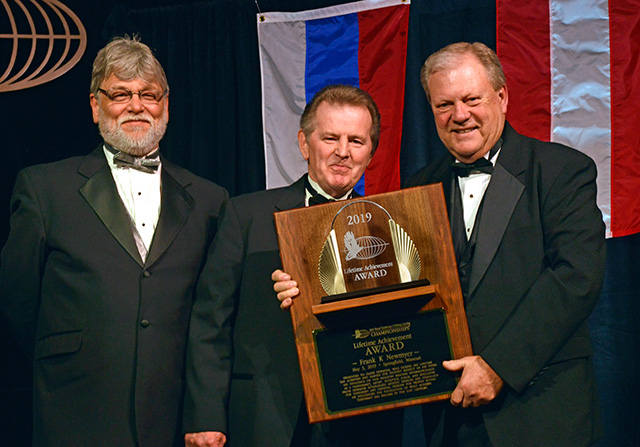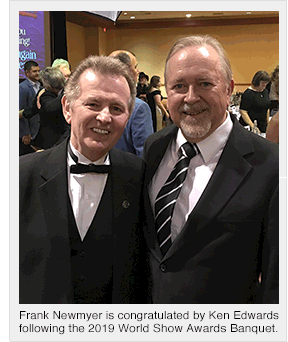
Date of Birth: 1950
Place of Birth: Detroit, Michigan
Current Location: Gladwin, Michigan
Frank Newmyer was born in 1950 in Eastside Detroit, Michigan. His father, Joe, was a veteran World War II pilot and a successful taxidermist and conservationist. Frank grew up immersed in the outdoors and was hunting and fishing every free moment he had. He was trapping to earn money to buy school clothes before the age of 10.
Recognizing his natural talent, his father introduced Frank to the basics of taxidermy. By his early teens he was mounting 75 to 90 birds each year.
On a family trip to the Chicago Field Museum, young Frank had an epiphany. What he saw on this visit, along with his parents’ encouragement, set into motion the creative spark which would have the greatest impact on his career.
Inspired by what he had seen at the museum, Frank and his dad build a mini-trophy room with glass panels and dioramas. Frank and his brother NAME would have “taxidermy competitions” with Brewer blackbirds. Frank’s father would judge, and Frank would always win!
After school, Frank would work every day in the family taxidermy shop. His father taught him the finer points of working with resins, foams, painting, drawing, woodworking, wrapping bodies and airbrushing. As a teenager, he began using foam to create habitats for his mounts.
A year after high school graduation Frank got married and worked at several odd jobs to supplement his taxidermy income to raise his family. His skill at airbrushing lead him to custom painting vans, motorcycles and cars. Now with two small children, Frank Jr. and Jaemi, in 1978 he made the move to full-time bird taxidermy on his own.
As he developed his style, Frank focused on artistic creativity and technical excellence. He raised live waterfowl, upland gamebirds, and whitetail deer for reference. His reputation flourished, and he was soon making taxidermy reference models for many top waterfowl carvers who were well known. This helped to boost his career into the upper echelon of the wildlife art world.
He began competing in the first Taxidermy Review shows in Denver in the seventies, and the NTA conventions in the early eighties, where he won 2 Best of Shows and a People’s Choice. When he heard about the new World Show planned for Atlanta, he knew that he had to be a part of it. At the first World Taxidermy Championships in 1983, he proved his talent, winning the first Carl E. Akeley award for the most artistic piece as well as four first-place Master titles.
The following year he won the very first Master of Masters award as well as several World Champion titles. By 1984, he was the most sucessful taxidermy competitor in the world.
With this success, many doors opened. Frank began writing for Breakthrough, judged several state duck stamp contests, appeared in several national magazines and judged the Ward World Carving show in Ocean City, Maryland.
His beautiful bird displays continued to evolve with never-before-seen water effects and artistic compositions. Frank’s evocative artwork was always a showstopper whenever he competed. His artificial water and splash work is still unsurpassed, even 25 years after he showed everyone else how he did it.
In the mid-eighties, Frank Newmyer was the first to produce artificial duck heads, sculpted bird bodies, cast duck feet and rocks, and a hardcover book on Gamebird Taxidermy.
Frank starred in several top-selling videos on creating habitats and mounting birds with WASCO. In the nineties, Frank remained active in competing and creating new forms of taxidermy displays as well as authoring six new bird taxidermy manuals. Along with Erling Morch, he introduced acrylic eyes in the United States.
He produced a number of bronzes for ducks unlimited as well life size sculptures for golf resorts.
Frank was a frequent seminar instructor at the World Taxidermy Championships, where he also judged a record 14 times. He was the youngest person ever inducted into the Taxidermy Hall of Fame, and attended numerous art shows throughout the country where he was the only taxidermist allowed to exhibit. He appeared on the cover of Breakthrough magazine 7 times, as well as the cover of all other taxidermy periodicals. He is the only person to have repeated a win of the Carl E. Akeley award at the World Show, winning in both 1983 and 22 year later in 2005.

Nicknamed by some as the “Father of Habitat”, Stefan Savides, who judged 10 World Shows with Frank, commented that, “Frank Newmyer is responsible for all this habitat at these taxidermy competitions that we have to look at.”
For the past 11 years, Frank has been the lead designer for the Mountain Team with The Wildlife Gallery. He has completed 52 mountain jobs in the US, Canada and Mexico. While other top taxidermists from the 1980s have retired from competing, Frank continues to push the envelope and bring cutting-edge artwork to the Master of Master division of World Shows for all to see and be inspired.
Many important firsts in artistic taxidermy were pioneered by Frank: water scenes, resin splashes, portholes for viewing underwater habitat, Plexiglass and glass cases, foam habitats, artificial foam rocks, sculpture integrated into taxidermy, snow and ice scenes, and many more. In 1997, Frank approached Larry Blomquist with the idea to introduce a Collective Artists Division at the World Show. Since then, there have been hundreds of beautiful entries by studios and collaborative efforts. Frank Newmyer won this new World title twice, in 1997 and in 2007.

